
Selecting the right furniture for your restaurant involves more than just choosing pieces that fit the aesthetic of your space. Durability, functionality, and the ability to withstand daily use are crucial factors that significantly impact your investment's longevity and your guests' comfort. This comprehensive guide combines detailed insights on materials, furniture construction techniques, and technical aspects to help restaurant owners make informed decisions when investing in furniture.
Understanding Furniture Durability
Durability in restaurant furniture is defined by several key factors, including construction techniques, material quality, and joinery. Well-constructed pieces stand the test of time, maintaining their structural integrity and appearance even under constant use.
Joints and Construction Techniques:
The durability of restaurant furniture largely hinges on the quality of its construction and joint techniques. Well-executed joints are essential for withstanding the frequent use typical in restaurant settings. Effective construction methods enhance furniture stability and prevent issues like wobbling, thus extending its service life and maintaining its aesthetic appeal in a busy environment.
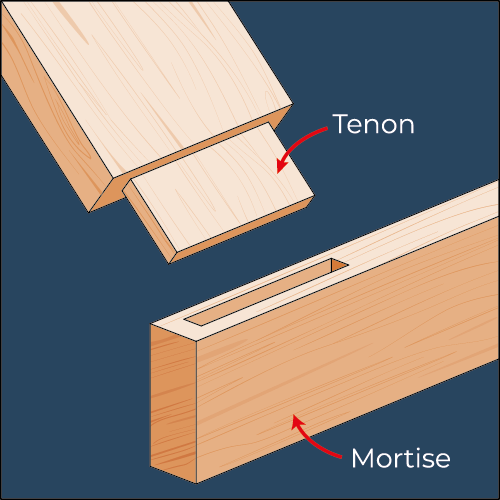
Mortise and Tenon Joinery
Renowned for its robustness, the mortise and tenon technique is an artisanal approach that fuses two pieces of wood into a seamless and strong bond. This joint is carved with precision, creating a 'mortise' hole and a 'tenon' tongue. The two are seamless and are often then reinforced with adhesives and/or fasteners for an even stronger bond. Given its strength and stability, this method is often used on furniture that has heavy daily use in commercial spaces, like dining chairs and heavy tables, ensuring a level of stability and sturdiness that withstands the test of time.
- Material: Solid wood (such as oak, beechwood, maple, or walnut)
- Furniture Types: Primarily used for robust commercial-grade wood chairs and bar stools. This joint technique is preferred for its strength in wood-to-wood bonding.
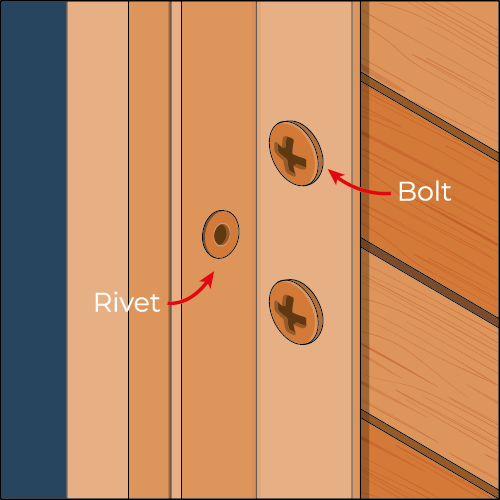
Bolted and Riveted Joints
Particularly in the realm of metal furnishings, bolted and riveted joints stand as strong supports. Bolted joints bring the advantage of modularity, allowing furniture to be dismantled for maintenance or transport. Rivets, on the other hand, guarantee a solid bond, apt for areas where furniture pieces must withstand heavy and constant use in hospitality venues — such as the structural beams of a booth or the frame of a barstool. Both are tailored for bustling, high-traffic zones where reliability is paramount.
- Material: Metals
- Furniture Types: In metal frame bar stools, chairs, and booth structures, bolted and riveted joints are crucial for durability and adjustability. Bolted joints are ideal for connecting different materials like metal to wood or metal to resin, allowing for easy adjustments and disassembly. Riveted joints, used primarily for metal-to-metal connections, ensure permanent and strong structural integrity.
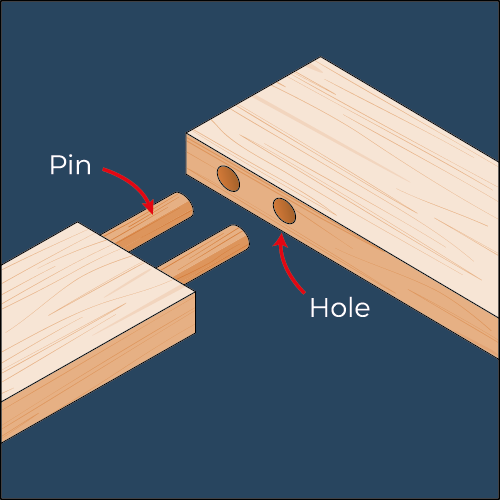
Dowel Joinery
Similar in concept to mortise and tenon, dowel joinery involves inserting small wooden rods — dowels—into matching holes in two pieces of wood. When glued, these dowels strengthen the joint, which can be more cost-effective than traditional mortise and tenon joints. Dowel joinery is commonly used in commercial furniture due to its ease of assembly and respectable durability. This method is particularly suitable for constructing items with repetitive designs or for pieces that require a less artisanal, more streamlined production process, while still maintaining a reliable build quality. It's a practical solution for restaurant furniture that balances budget concerns with the need for durability.
- Material: Wood or engineered woods like plywood or MDF (Medium-Density Fibreboard)
- Furniture Types: Common in mass-produced cafe tables and lightweight chairs, where cost-effectiveness and ease of assembly are crucial.
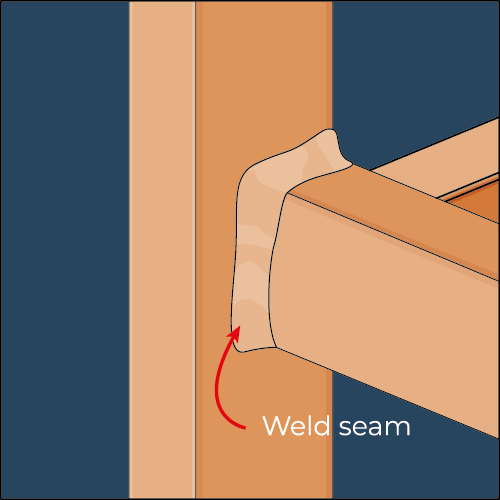
Welded Joints
Welding is a formidable construction method where metal parts are fused together using high heat, commonly used in metal restaurant furniture. This process creates a bond that's as strong — if not stronger — than the base metal itself, ensuring an exceptionally durable join. Welded joints are particularly suited for outdoor furniture or pieces that must withstand significant weight or stress, such as metal barstools or steel frames of booths. Since they are permanent, welded joins are ideal where the strength of the furniture is paramount, and they contribute to a sleek, seamless look with added resilience against the rigors of a busy restaurant environment.
- Material: Metals (such as galvinized steel, aluminum or stainless steel)
- Furniture Types: Outdoor commercial-grade metal furniture like tables, chairs, bar stools, and benches benefit from welded joints, which provide a permanent, corrosion-free, high-strength bond ideal for handling heavy use in any weather conditions.
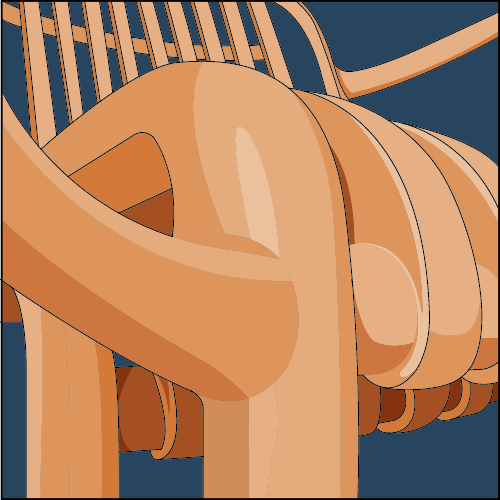
Molded Furniture
In the realm of modern furniture manufacturing, molded joinery represents the fusion of design and technology. This method involves shaping materials such as plastics, polymers, or composites in molds to create furniture or components in a single, uniform piece. The absence of separate joining parts means there's no risk of loosening over time, which is especially beneficial for items exposed to constant movement or weight shifts. Molded pieces are typically lightweight, yet strong, and can withstand environmental stresses, making them perfect for both indoor and outdoor use in casual dining settings or contemporary restaurant lounges. Their sleek, fluid designs offer not only comfort and durability but also contribute to a clean, modern aesthetic.
- Material: Plastics, polymers, or composites (like fiberglass or resin)
- Furniture Types: Modern designs in indoor and outdoor seating, such as stylish contemporary chairs and lounges, often use these materials for their ability to be shaped into durable, seamless forms.
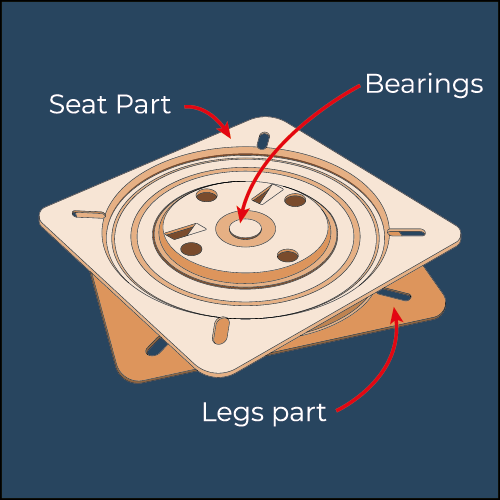
Swivel Mechanism
To marry functionality with comfort, swivel, and reclining mechanisms are the secret sauce. These intricate systems enable rotation and movement, providing that extra level of luxury to seating options like bar stools. High-quality mechanisms defy wear, resist strain, and operate with a whisper of motion — crucial for bar stools that pivot and lounge chairs that recline. They not only contribute to a diner's comfort but also enhance the longevity of the furniture, preventing strain on other parts and preserving the chair's original form and function.
- Material: Combination of metal (often steel) and durable plastics for the mechanism parts
- Furniture Types: Utilized in bar stools and lounge chairs to provide a rotating function, these mechanisms are built to withstand frequent use and offer flexibility in seating positions.
Material Considerations
Selecting the right materials is crucial for achieving both aesthetic goals and longevity:
Metal:
- Aluminum: Known for its lightweight and corrosion-resistant properties, aluminum is a top choice for outdoor furniture. Its ease of maneuverability makes it perfect for patios and garden settings where furniture may need to be moved frequently. However, despite its rust resistance, aluminum furniture should be anodized or coated to protect against the elements and maintain its appearance. Furniture made of aluminum is ideal for casual dining, Ice cream shops, cafes, and bistros with outdoor areas. Its lightweight nature makes it perfect for patios and rooftops where furniture may be rearranged frequently to accommodate different numbers of guests or events.
- Stainless Steel: Celebrated for its strength and modern look, stainless steel is highly resistant to rust and corrosion, thanks to the addition of chromium. This makes it an excellent option for both indoor and outdoor use, especially in coastal areas where salt air is prevalent. Stainless steel's heft contributes to its stable, sturdy feel, but also means it's less likely to be moved around easily. Furniture made of stainless steel is best suited for modern, high-end restaurants and commercial kitchens due to its sleek look and durability. It's also a popular choice in diners and fast-casual establishments that prioritize cleanliness and longevity.
- Powder-Coated Steel: Powder coating adds a layer of protection to steel furniture, enhancing its resistance to rust, scratches, and fading. This process involves electrostatically applying a dry powder and then curing it under heat, resulting in a hard finish that is tougher than conventional paint. Powder-coated steel is versatile, offering a range of colors and finishes, making it suitable for both indoor and outdoor settings that demand durability without compromising on style. Furniture made of powder-coated steel fits a wide range of settings, from industrial-themed restaurants and cafes to outdoor areas in all types of dining venues. The variety of finishes and colors available makes it adaptable to many decor styles.
Wood:
Hardwoods offer natural beauty and durability, though they require regular maintenance to preserve their appearance and structural integrity. Traditionally used in fine dining, steak houses, and classic bistros that aim for a warm, upscale ambiance. Hardwood furniture adds a sense of elegance and timelessness to the dining experience, appealing to establishments that wish to create a memorable and sophisticated setting for their patrons.
For an in-depth comparison of wood types for restaurant furniture, visit our latest article: Exploring the Best Wood Choices for Restaurant Furniture
Resin and Plastics:
These materials offer flexibility in design and are easy to clean and maintain, making them ideal for outdoor dining areas.
- Resin: Particularly suited for poolside bars, beachfront cafes, and any restaurant with significant outdoor seating. Its durability against the elements and easy maintenance make it a practical choice for high-traffic areas focused on casual dining and relaxation.
- Plastics: High-quality, design-forward plastics are often found in modern eateries, quick-service restaurants, and trendy cafes looking to inject vibrant colors and contemporary shapes into their spaces. They're also popular in family-friendly restaurants due to their durability and ease of cleaning.
Upholstery Materials:
- Vinyl: Vinyl is celebrated for its exceptional durability and ease of maintenance, making it an ideal choice for high-traffic indoor environments such as diners, clinics, and children's play areas. Resistant to spills, stains, and abrasions, vinyl upholstery can endure the rigors of daily use without compromising on appearance. Its ability to mimic the look of more expensive materials, like leather, at a lower cost also makes it a popular choice for budget-conscious settings. However, vinyl may not be suitable for outdoor use due to its tendency to heat up in direct sunlight and its susceptibility to cracking over time under harsh weather conditions.
- Fabric: Fabric upholstery offers incredible versatility in textures, colors, and designs, allowing it to blend seamlessly with any interior décor. For durability, synthetic fabrics like microfiber are recommended as they are specifically engineered to resist stains and fading, ideal for areas that receive a lot of natural light. While fabric offers a softer and more comfortable seating experience, it is best used indoors unless specially treated for outdoor use, as the regular fabric can absorb moisture and degrade quickly when exposed to the elements.
- Natural Leather: Natural leather is a premium material known for its durability and the unique way it ages, gaining character and softness over time. Ideal for settings that aim for a sophisticated aesthetic, such as executive offices, luxury vehicles, and upscale restaurants, leather can handle significant use and is easy to clean, maintaining its elegance. While generally recommended for indoor use, treated or marine-grade leather can be used outdoors due to its enhanced ability to withstand moisture and UV rays. However, regular conditioning is required to maintain its resilience and prevent cracking.
Each material serves distinct restaurant concepts and environments, influencing not just the aesthetics but also the practical aspects of maintenance and longevity. Metal brings an industrial or sleek modern feel, wood offers warmth and refinement, while resin and plastics provide flexibility and a contemporary touch. The choice of material can enhance the dining experience, reflect the restaurant's identity, and withstand the specific demands of the restaurant's operational environment.
Technical Aspects Affecting Longevity
Frame Construction
The backbone of any furniture piece is its frame, which supports the weight and use over time. Hardwood frames, known for their rigidity and resilience, are preferred in settings where the furniture's aesthetic longevity is as important as its structural integrity. On the other hand, stainless steel frames offer unmatched durability and strength, making them ideal for both indoor and outdoor use, especially in environments prone to moisture which can lead to corrosion in less durable metals. The choice between hardwood and stainless steel often depends on the desired aesthetic, the expected wear and tear, and the environmental conditions of the restaurant.
Surface Treatments
Protective finishes on wood and coatings on metal furniture extend their life by protecting against environmental damage.
Wood Finishes. Applying protective finishes to wood, such as varnish, lacquer, or sealants, can significantly enhance its resistance to water, scratches, and UV light. This not only preserves the wood's natural beauty but also prevents warping and rotting over time. In dining areas, where spills and stains are common, such treatments are invaluable for maintaining the appearance and functionality of wood furniture.
Metal Coatings
Metals, particularly iron and steel, benefit from coatings like powder coating or galvanization. Powder coating provides a hard finish that is more durable than traditional paint, offering resistance to scratching, chipping, fading, and wear. Galvanization, the process of applying a protective zinc coating to steel or iron, can prevent rust and corrosion, thereby extending the life of metal furniture exposed to the elements.
Upholstery Attachment
The longevity of upholstered furniture significantly depends on how the upholstery is attached to the frame. Traditional methods like stapling or tacking, while efficient, may loosen over time with heavy use. More durable methods, such as using industrial adhesives or integrated frame designs where the upholstery is part of the mold (in the case of certain plastics or resins), ensure a secure fit that resists wear and tear. Additionally, the type of fabric or leather, along with its treatment (e.g., stain resistance, UV protection), plays a crucial role in the upholstery's durability and maintenance needs.
Adjustable Features
For furniture with adjustable features, such as bar stools with height adjustment or chairs with recline functions, the quality of the mechanisms is paramount. High-quality, commercial-grade mechanisms can withstand the rigors of frequent adjustments and heavy use without failing. This includes pneumatic or hydraulic lift mechanisms for bar stools and durable pivot points for reclining chairs. Such features should be designed for ease of use and repair, ensuring that the furniture continues to function as intended through repeated use.
Best Practices for Furniture Care
Make a connection as to how the material and the finish on that material will dictate the type of maintenance required.
Routine Cleaning:
- Material-Specific Cleaners: It's crucial to use the right cleaning products for each type of material. For wood, mild soap and water followed by a dry cloth can prevent moisture damage, while specific wood cleaners can nourish and protect the surface. Metal furniture, especially stainless steel, benefits from cleaners that remove fingerprints and smudges without corroding the material. For upholstery, using cleaners formulated for the specific fabric type (e.g., leather, polyester) can help remove stains without damaging the fibers.
- Frequency and Technique: Establish a cleaning schedule that reflects the use and type of furniture. Daily cleaning may be necessary for high-use areas, whereas less frequently used pieces can be cleaned on a weekly basis. Employ gentle cleaning techniques, using soft cloths or brushes to avoid scratching surfaces.
Protective Floor Glides:
- Floor Protectors: Using protective pads under the legs of chairs, tables, and other furniture can prevent scratches and damage to flooring. Felt pads are ideal for indoor furniture, while rubber pads might be better suited for outdoor pieces to withstand moisture. Additionally, these pads can significantly reduce noise caused by moving furniture, creating a more pleasant dining environment.
- Replacement and Quality: Check and replace these pads regularly as they can wear down or fall off over time. Investing in high-quality pads can provide better protection and last longer.
Periodic Inspections:
- Check for Damage: Regularly inspecting restaurant furniture is crucial not only for maintaining its appearance but also for ensuring safety and avoiding liability issues. Even furniture that seems stable can have hidden dangers, such as loose screws or weakened joints, which may lead to accidents like falls or breaks during use. Pay close attention to signs of wear, including cracks in wood or rust in metal furniture, especially in concealed areas. Addressing these issues promptly helps prevent potential safety hazards and protects your restaurant from legal and financial repercussions, ensuring a secure and welcoming environment for both guests and staff.
- Address Issues Promptly: Upon finding any damage, take immediate action to repair or replace the affected part. Tightening loose screws, applying touch-up paint to scratched metal, or using wood filler for minor cracks can prevent further deterioration. For upholstery, consider professional cleaning or repair for tears or stubborn stains.
- Preventive Measures: If certain pieces show signs of wear due to specific environmental conditions (e.g., sunlight fading, moisture damage), consider repositioning furniture to less harsh environments or using protective covers when not in use. Implementing these best practices for restaurant furniture care not only extends the life of your investments but also contributes to the overall ambiance and comfort of your dining space, ensuring a welcoming environment for your customers.
Investment Insights
Investing in the right restaurant furniture goes beyond mere aesthetics; it's a strategic decision that impacts both operational costs and customer satisfaction. Here’s a deeper look into how investing in quality furniture can benefit your restaurant:
Long-Term Cost Savings:
High-quality, durable furniture might have a higher initial price tag, but it significantly reduces the frequency of replacements and repairs over time. Furniture made from superior materials and construction methods can withstand the rigors of daily use in a busy restaurant, maintaining its functionality and appearance for years. This durability translates into savings, as the need to purchase new furniture becomes less frequent compared to cheaper, less durable options that may need replacing after a short period.
Additionally, investing in furniture that comes with warranties or guarantees can offer further financial protection, ensuring that any unforeseen issues are covered without additional cost to the restaurant.
Enhanced Guest Satisfaction:
The quality of furniture directly influences the dining experience. Comfortable seating, sturdy tables, and well-maintained decor contribute to a positive impression, making guests more likely to enjoy their time and return in the future. Quality pieces also speak to the establishment’s commitment to excellence, reinforcing the restaurant’s brand and reputation.
Furniture that aligns with the restaurant's theme and ambiance plays a crucial role in creating an immersive dining environment. Whether aiming for a cozy, rustic feel or a sleek, modern vibe, the right furniture can complete the desired look, enhancing the overall dining experience.
Customer Loyalty and Word-of-Mouth:
A pleasant dining environment, supported by high-quality furniture, encourages customer loyalty. Satisfied guests are more likely to become repeat customers and also act as brand ambassadors, sharing their positive experiences with friends and through social media. This word-of-mouth marketing is invaluable, as personal recommendations carry significant weight in attracting new customers.
In the age of online reviews, where every aspect of the dining experience can be scrutinized, ensuring that your furniture contributes positively to guest comfort and satisfaction can help garner positive feedback, boosting your restaurant's online presence and appeal.
Sustainability and Brand Image:
Investing in sustainable, high-quality furniture can also enhance your restaurant’s brand image, especially among environmentally conscious consumers. Furniture made from renewable resources, featuring eco-friendly designs, or crafted by local artisans can reflect your restaurant’s commitment to sustainability and community support. This not only appeals to a growing demographic of eco-aware diners but also contributes to a more responsible and ethical business model.
Considering these insights, it's clear that the initial investment in quality restaurant furniture is a strategic choice that impacts not just the aesthetic appeal of your establishment but its financial health and reputation in the long run. By prioritizing durability, style, and sustainability, you can create a welcoming environment that delights guests, encourages repeat business, and ultimately supports your restaurant’s success.
Conclusion
By understanding the importance of durability in restaurant furniture and following these guidelines for selection and maintenance, restaurant owners can ensure their furniture investment is both beautiful and built to last. This approach not only enhances the aesthetic appeal of your space but also ensures your furniture withstands the rigors of daily use, providing a comfortable and inviting environment for your guests.



